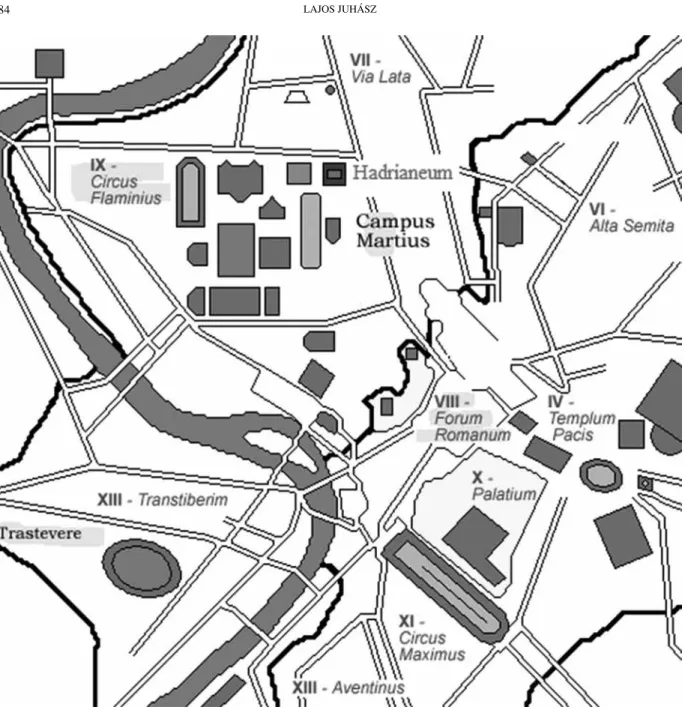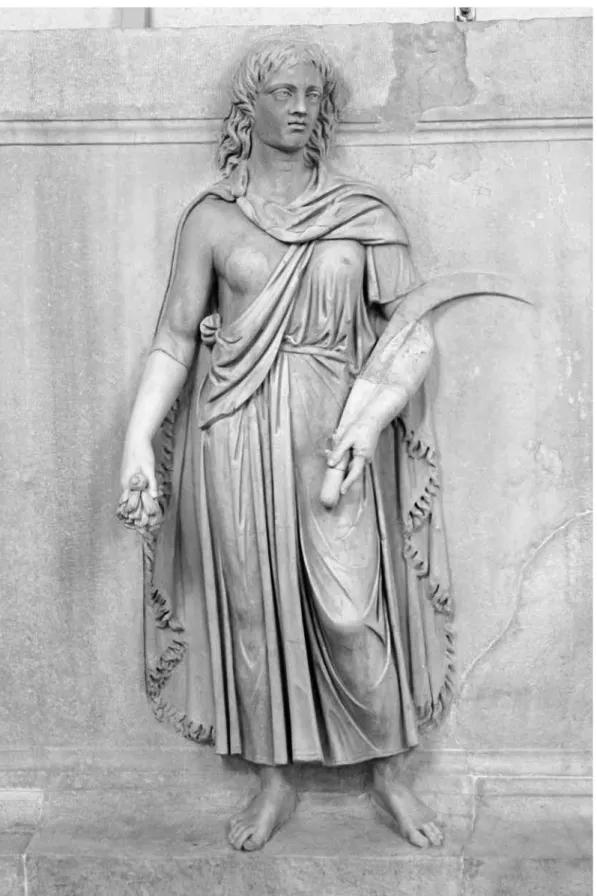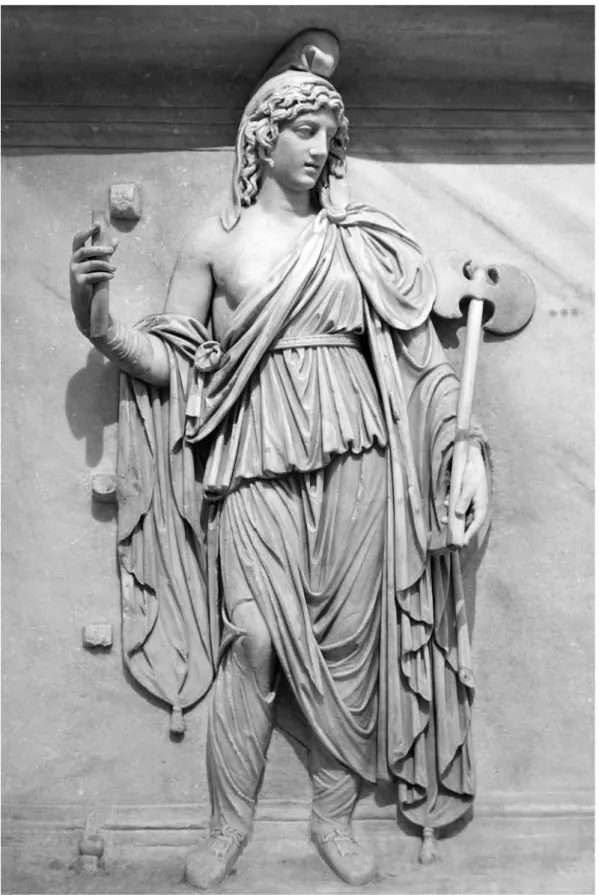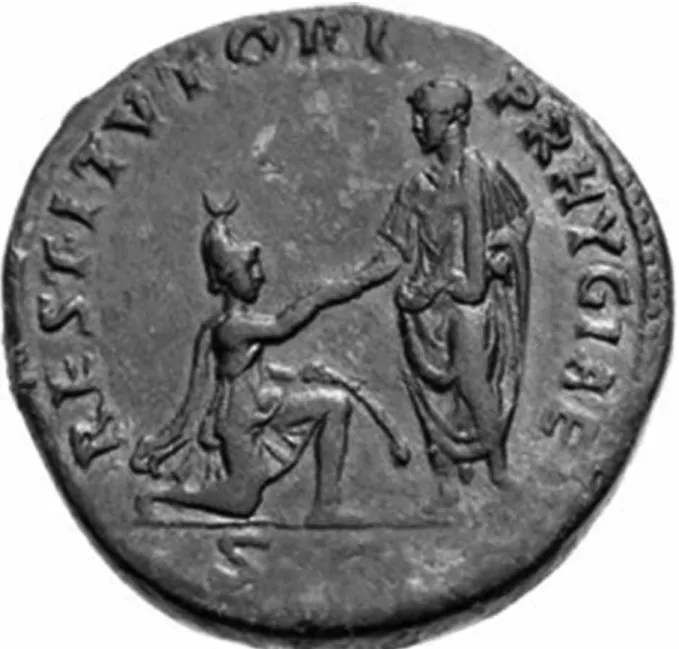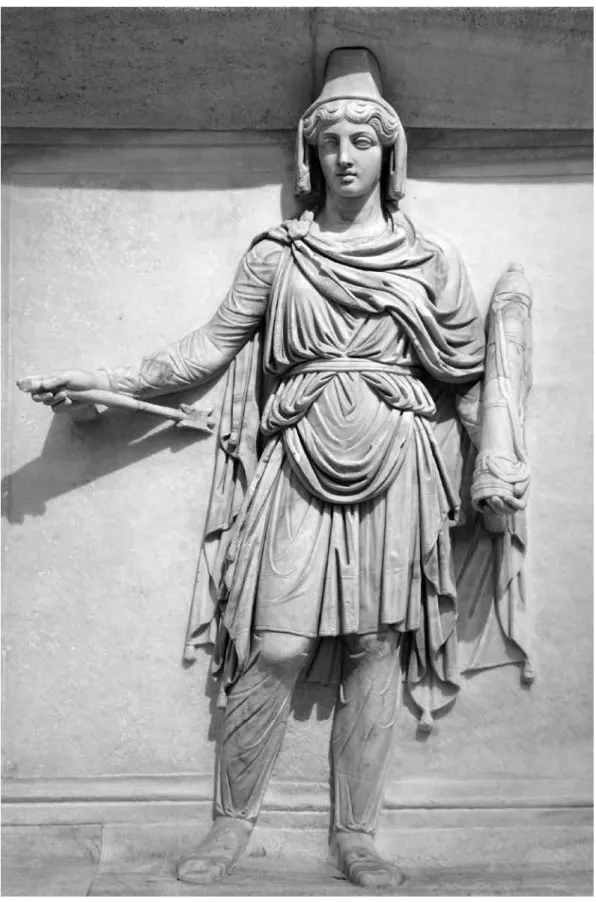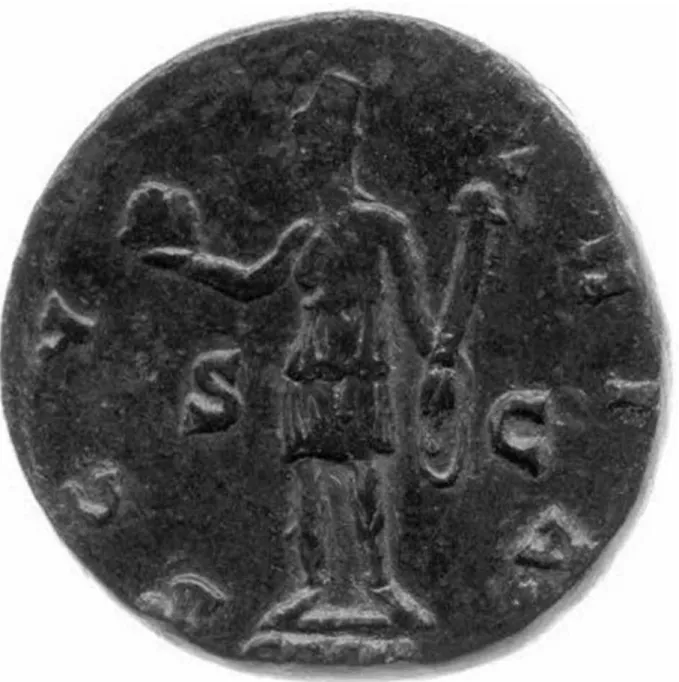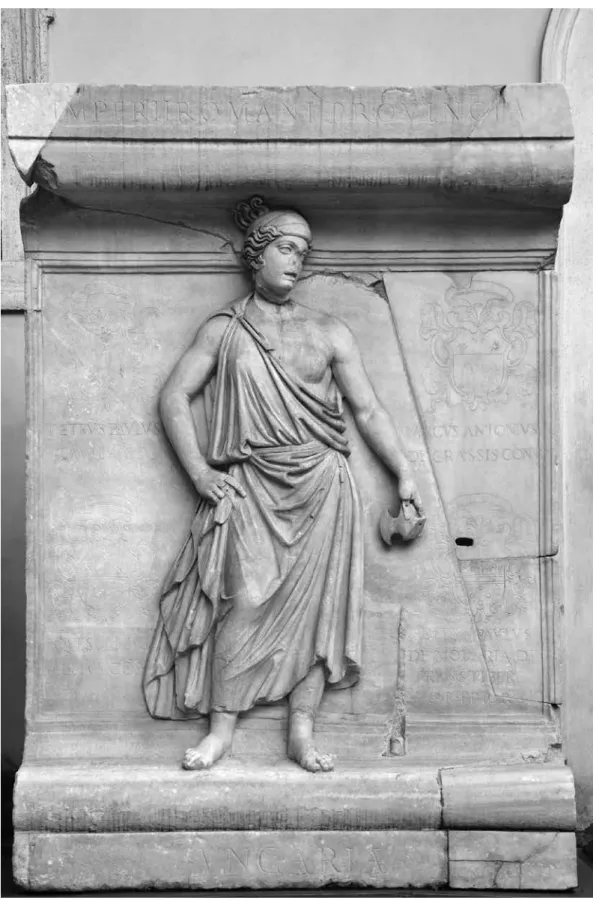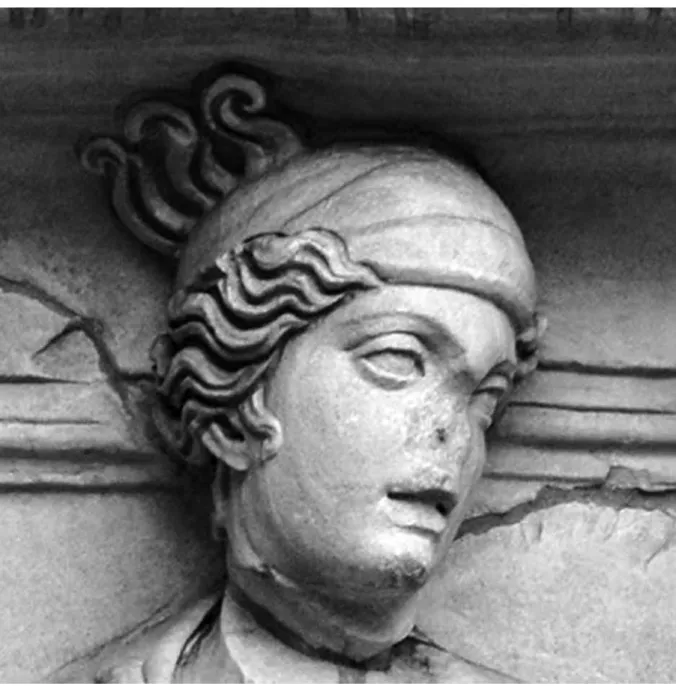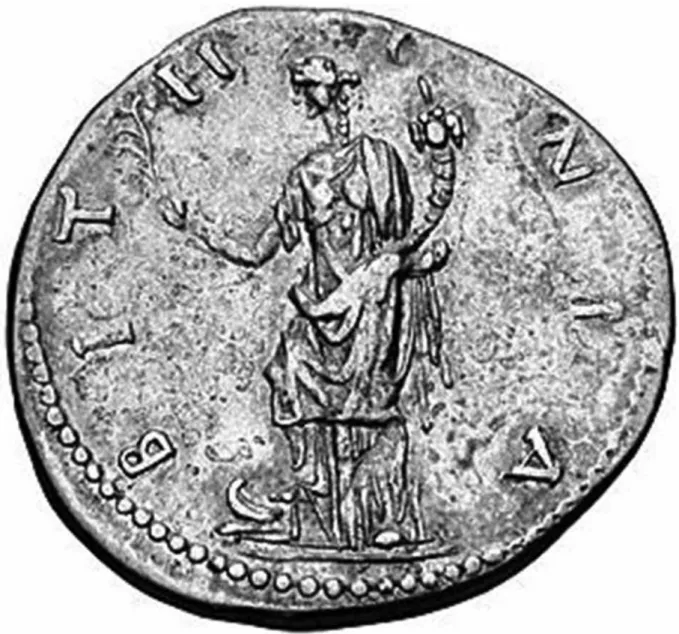Abstract: The reliefs of the Hadrianeum in Rome still pose a lot of difficulties even several centuries after their discovery.
This meant a number of varying identification proposals from different scholars. Some of them are too fragmentary to ever to be solved, but in this paper I propose some modifications to the previous readings based on iconographic parallels.
Keywords: Hadrianeum, iconography, coins, reliefs, identification, Rome
The Hadrianeum i.e. the temple of the deified Hadrian was decorated with a series of very interesting, but also very problematic reliefs. A great number of attributes now lost, but once existing has led to several different and often unsubstantiated interpretations.
1Because of the two coin series, Hadrian’s province and Antoninus Pius’
aurum coronarium, it is likely that the reliefs show provinces or other parts of the Roman Empire, or maybe even foreign territories. However, the series are not complete or to be more precise, we do not know according to which system or idea the coin reverses were selected and minted.
2So how can we transfer the thought not fully understood to the reliefs, we are not able to identify certainly? The reason for correlating the two is the close proximity in time and the uniqueness of the representations.
3The present article would like to propose some new interpretations to some of the reliefs, and add some notes confirming two previous readings, while admitting that most of them cannot be sufficiently identified at present date.
The temple
4itself was dedicated by Antoninus Pius in 145 A.D. and was located in the centre of the Cam- pus Martius in Rome, south of the buildings erected by Augustus, on today’s Piazza di Pietra (Fig. 1).
5North of it ran the via Recta between the via Flaminia and the pons Neronianus.
6To the west lay the monuments of Matidia and Marciana erected by Hadrian. The choice of location by Antoninus Pius continued to use the middle of the
SOME NOTES ON THE HADRIANEUM RELIEFS
LAJOS JUHÁSZ
Department of Classical and Roman Archaeology, Institute of Archaeological Sciences Eötvös Loránd University Budapest
4/B Múzeum krt., H-1088 Budapest, Hungary jlajos3@gmail.com
Acta Archaeologica Academiae Scientiarum Hungaricae 69 (2018) 83–96 DOI: 10.1556/072.2018.69.1.2
1 Lucas 1900, 28–42; sapeLLi 1999, 28–82; Toynbee
1934, 155–159. For a summary of the previous interpretations, see osTrowski 1990, 216–219.
2 Hadrian’s province coins were minted between 134–138 and comprises of 3 different (provincia, adventus, restitutor) series de- picting provinces, cities, regions and the Nile. It was most likely a homage to his great journeys across the Empire. There also existed an exercitus series depicting the various Roman troops. Antoninus Pius emitted his smaller aurum coronarium series in 139, where provinces and foreign empires celebrated his accession. RIC II, 838–966; RIC III, 574–596; Toynbee 1934, 24–147; sTrack 1933, 139–166; ZahnrT
2007, 195–212; ViTaLe 2012, 156–174; houghTaLin 1996, 504–507.
3 The concentration of the personifications of geographical territories in imperial art in the first half of the 2nd c. A.D. is also in connection with that Trajan and Hadrian were themselves born in the provinces and not Italy.
4 SHA Pius 8,2; sapeLLi1999, 12–23; Toynbee 1934, 152–159; LiVerani 1995, 229–233; Lucas 1900, 1–28; pais 1979, 3–4, 11–35; osTrowski 1990, 216–219.
5 The temple was previously identified as the Neptune ba- silica renovated by Hadrian. papi2005, 52; SHA Hadrian 19,10;
parisi presicce 2005, 76–77. For the construction works of Hadrian see birLey 1997, 111.
6 boaTwrighT 2010, 171–172.
LAJOS JUHÁSZ 84
Campus Martius as a place of dynastic representation. Hadrian’s deification was not easy to pass through in the Senate, so probably the erection of his temple was also not without hurdles, especially at this location.
7The Hadrianeum was a peripteros temple oriented towards east with 8×13 columns.
811 of these on the north side are still standing decorating the building of the Camera di Commercio, Industria, Artigianato e Agri- coltura di Roma (Fig. 2). The edifice stood on a 90×100 m square surrounded by portico, thus forming a delimited space around the place of worship. Its north part housed an exedra also serving judicial purposes.
9The portico was
Fig. 1. Map of the ancient Campus Martius with the Hadrianeum (Modified by the author - original from Joris https://commons.wikimedia.org/wiki/File:Plan_Rome-_Tempel_van_Hadrianus.png)
7 The relationship between Hadrian and the Senate was quite poor in his last years. papi 2005, 52–54.
8 The building housed the stock exchange from 1870.
sapeLLi 1999, 13–14; parisi presicce 2005, 78–82.
9 For the exedra as a judicial building, see parisi presicce
2005, 96–98.
NOTES ON THE HADRIANEUM RELIEFS 85
lower than the temple so the Hadrianeum dominated the whole complex with its height (Fig. 3). This can be under- stood allegorically as Hadrian having been the head of the Roman Empire in his lifetime, following his death be- came its divine ruler.
10An arch stood at the eastern part of the portico by the via Flaminia, which was destroyed before 1527 so its connection to the Hadrianeum is unclear.
11Fig. 2. The Hadrianeum today (FollowingHadrian – https://en.wikipedia.org/wiki/Temple_of_Hadrian#/media/File:Temple_of_Hadrian.jpg)
Fig. 3. Reconstruction of the Hadrianeum with portico
(Lalupa – https://en.wikipedia.org/wiki/Temple_of_Hadrian#/media/File:Colonna_-_Tempio_di_Adriano_ricostruzione_1000165.JPG)
10 cLaridge 1999, 125. 11 parisi presicce 2005, 82; boaTwrighT 2010, 176–177.
LAJOS JUHÁSZ 86
Fig. 4. Dacia on the Hadrianeum (Miguel Hermoso Cuesta
https://it.wikipedia.org/wiki/Tempio_di_Adriano#/media/File:Hadrianeum_Tracia.JPG)
NOTES ON THE HADRIANEUM RELIEFS 87
Fig. 5. Phrygia on the Hadrianeum
(Marie-Lan Nguyen – https://it.wikipedia.org/wiki/Tempio_di_Adriano#/media/File:Bithynia_Hadrianeum_MAN_Napoli_Inv79_n01.jpg)
LAJOS JUHÁSZ 88
The most intriguing parts of the Hadrianeum are undoubtedly its sculptural decorations that came to light from the 16
thc. onwards at various times.
12Until today 25 reliefs survived: 18 female personifications and 7 depict- ing only weapons and tropaea.
133 others are only known to us via illustrations. It has long been debated which part of the temple the slabs decorated, but today the most likely emplacement seems to be on the attic of the surrounding
12 This accounts for why the reliefs are now scattered in various Italian collections. Musei Capitolini–Palazzo dei Conservatori (8 pieces), Museo Archeologico Nazionale Napoli (3 pieces), Palazzo Massimo alle Terme (2 pieces), Villa Doria Pamphilj – Casino del Belrespiro, walled in (2 pieces), Palazzo Farnese (1 piece), Camera di Commercio, Industria, Artigianato e Agricoltura di Roma (1 piece), Musei Vaticani – Museo Gregoriano Profano (1 pieces). For the de- tailed history of the reliefs’ appearance see cLaridge 1999, 117–121;
parisi presicce 2005, 78–94; pais 1979, 11–27.
13 The relief walled into the side of the Roman Palazzo Senatorio, depicting the bust of Africa, was previously considered to be a part of the Hadrianeum. However, the reliefs do not show any similarities apart from their theme. sapeLLi 1999, 14–17, 28–82; pais
1979, 35–95; papi 2005, 64; dodero2010, 60–68/13–15; domes
2007, Re. 2; saLcedo 1996, 108; osTrowski 1990, Africa 27;
FranZoni– TempesTa 1992, 23–24; LiVerani1995, p. 230. n. 44;
maTZ–duhn III, 3624; bieńkowski 1900, 94/61; JaTTa 1908, 33/20;
sapeLLi 1999, 76/25.
Fig. 6. Phrygia on the coin of Hadrian 134-138 A.D. (Classical Numismatic Group, Inc. http://www.cngcoins. – 12/01/2014 Lot 950)
NOTES ON THE HADRIANEUM RELIEFS 89
Fig. 7. Relief of Scythia
(Marie-Lan Nguyen – https://it.wikipedia.org/wiki/Tempio_di_Adriano#/media/File:Armenia_Hadrianeum_MAN_Napoli_Inv79.jpg)
LAJOS JUHÁSZ 90
portico.
14The personifications were placed above the columns alternating with the arms between them. This em- placement has parallels on the Forum Transitorium, Forum Traiani or the Sebasteion at Aphrodisias, where the personifications of ethne and provinces decorated these places.
15The Hadrianeum relief slabs showing personifications are of a maximum size of 2.08×1.90×0.85 m from Proconnesian marble, their bottom and top significantly protruding. They all have in common that the female
Fig. 8. Scythia on the coin of Antoninus Pius 139. A.D.
(British Museum Collection Database. “RE4p191.1196” www.britishmuseum.org/collection, British Museum. Online. Accessed 29/03/2017)
14 For a summary of the various interpretations, see cLaridge 1999, 121–125; papi 2005, 60; parisi presicce 2005, 88–94;
Toynbee 1934, 153–155.
15 sapeLLi 1999, 21–22; smiTh 1988, 50–70; papi 2005, 58–62; seeLenTag 2004, 308–315, 363–366; ÖsTenberg 2009, 29–30.
Summarizing the latest excavations’ results carried out on the Forum Traiani, see miLeLLa 2007, 192–211; meneghini 2009, 117–163.
NOTES ON THE HADRIANEUM RELIEFS 91
Fig. 9. Bithynia (?) on the Hadrianeum
(Carole Raddato – https://followinghadrian.com/2015/01/21/the-hadrianeum-and-the-personifications-of-provinces/)
LAJOS JUHÁSZ 92
figures are facing the viewer, their engaged and free legs changing from slab to slab.
16The identification of the figures in high relief set against a polished background are, as mentioned before, very problematic till this day. The biggest difficulty arises from the lack of exact parallel depictions despite Hadrian’s and Antoninus Pius’ coin series minted few years before. This is further augmented by their fragmentary condition and lack of inscriptions.
17Fur- ther issues are raised by modern restorations resulting in often completely fictional attributes in the hands of the personifications.
Two reliefs have previously been identified convincingly, so here I only wish to add some supporting re- marks. One is in the Palazzo Massimo alle Terme (Inv. 428496) depicting a female figure wearing long tunic leav-
Fig. 10. Detail of the head of Bithynia (?)
16 parisi presicce 1999, 96–97.
17 The Hadrianeum was later used as a quarry, hence the modern Piazza di Pietra name. papi 2005, 58. According to
N. Hannestad’s theory the names of the provinces were painted on the reliefs, so that the ancient viewers could identify them. hannesTad
1986, 198.
NOTES ON THE HADRIANEUM RELIEFS 93
ing one breast bare and fringed cloak, holding sica in her left hand (Fig. 4).
18The forearms and the attribute held in the right hand are modern additions. The sica however is valid, because the greater part of it is still preserved at the elbow and on the background. On the basis of this attribute P. Bieńkowski proposed the identification as Dacia, which was accepted amongst others by M. Jatta and J. Ostrowski.
19However, J. M. C. Toynbee rejected it seeing rather Thracia represented on the relief, a theory later also accepted by the LIMC.
20This has to be refuted, not only on the basis of the sica, but also because of the great resemblance with Antoninus Pius’ Dacia coin.
21Both are wear- ing the same kind of tunic leaving one breast bare and mantle, while holding sica in their left hand. The appearance of the latter attribute and the lack of the pileus can be seen in Dacia’s iconography since Hadrianic times.
22Fig. 11. Bithynia on a locally minted coin of Hadrian (Gemini Auction – Auction II 11/01/2006 Lot 401)
18 maTZ-duhn III, 3623; Lucas 1900, 8–9/F; bieńkowski
1900, 68–70/38; sTrong 1907, 389/6; JaTTa 1908, 44–45/4; Toynbee
1934, 159; osTrowski 1990, Dacia 23; pais 1979, 55-57/8;
houghTaLin 1996, Dacia 38; LIMC Thracia 2; sapeLLi 1999, 48–51/9.
19 bieńkowski1900, 68–70/38; JaTTa 1908, 44–45/4;
osTrowski 1990, Dacia 23.
20 Toynbee 1934, 159; LIMC Thracia 2.
21 Toynbee 1934, 148–149, Pl. 8/3.
22 RIC II, 829, 849–850.
LAJOS JUHÁSZ 94
The other Hadrianeum relief is in Naples depicting a personification wearing short chiton, himation, brac- cae, shoes and Phrygian cap, holding double axe (Fig. 5).
23The end of the long staff held in her right hand is now lost, thus there is no possibility to identify it. The labrys together with the amazon-like appearance point in the di- rection of Anatolia, while the Phrygian cap identifies the female figure as Phrygia.
24This is further supported by Hadrian’s restitutor coin where her clothes also go under one shoulder, just like on the relief (Fig. 6).
25The attributes held in the hands differ, but this does not necessarily undermine the validity of the interpretation. The pedum can both be seen on the adventus and restitutor coins, but not the labrys. Could thus the lost attribute in the right hand of Phrygia on the relief be a pedum? The length of the staff reaching to the ground suggests otherwise, although some examples show it with a longer shaft.
Of the two newly interpreted reliefs the one kept in Naples (Inv. 6757) depicts a female figure wearing short tunic, mantle, braccae, shoes and an unusual rectangular headgear, while holding arrow and quiver (Fig. 7).
26Because the headdress was previously interpreted as a tiara, it was identified with Armenia or Parthia that the weap- ons would also support. However the braccae, quiver and the strange headdress correspond much closer to Scythia’s guise on Antoninus Pius’ coin (Fig. 8). This leads me to suggest that the relief does not represent a part of the Roman Empire itself, but rather the foreign territory of Scythia. This is in concordance with Antoninus Pius’ aurum coro- narium series, where also Parthia is depicted.
27The other suggestion put forward here is regarding a relief kept in the Palazzo dei Conservatori (Inv. 761).
The female figure is wearing a tunic leaving her left breast bare, holding a labrys in her left hand, while resting the other on her hip (Fig. 9).
28Her hair deserves special attention, since the three locks distinctly protruding from under a cap-like headdress and ending in curls are unique (Fig. 10). It resembles an aplustre, which is only found as an attribute of Bithynia. On Hadrianic coins she is twice represented with it. On one restitutor type she is kneeling and holding aplustre, prora before her.
29The other is a Bithynian cistophorus on which Bithynia is standing, setting one foot on prora, while holding cornucopia and aplustre (Fig. 11).
30The amazon-like attire on the relief, together with the labrys also points to Anatolia, which could strengthen her identification as Bithynia. The aplustre although not a hair decoration, but a symbol of maritime power and victory, is usually held in the hand. In Bithynia’s case, it most likely refers to its strategic importance.
31It is interesting to note the same iconographic perception reflected on the local provincial as well as the central Roman pieces.
So, as it could be seen the Hadrianeum reliefs can at least to some extent be correlated with Hadrian’s and Antoninus Pius’ coin series.
32However most of them follow a quite different iconography, ones we currently are not able to solve. Despite of its fragmentary survival it seems evident that the Hadrianeum sculptures had a some- what different ideological background and purpose as the coin series. Unique is e.g. the relief depicting a female figure in cuirass.
33Furthermore the personifications are divided by weapons making the Hadrianeum’s decoration much more militant. This is surprising since Hadrian gave up the eastern territories conquered by Trajan just before his death and turned the resources to the Empire’s consolidation, not expansion. Nonetheless it is important to state that the personifications are not represented in a defeated manner, which corresponds to the coin series.
34Antoni- nus Pius followed Hadrian’s peace policy and apart from the early conquest in Britain did not try to expand the
23 Lucas 1900, 6–7/C; bieńkowski 1900, 66–68/59;
sTrong 1907, 388–389/3; JaTTa 1908, 44/2; Toynbee 1934, 158; pais
1979, 45–47/3; LIMC Phrygia 3; osTrowski 1990, Bithynia et Pontus 6=Phrygia 7; sapeLLi 1999, 36–37/5; dodero 2010, 67–68/15.
24 chrisToF 2001, 135–145; TyreLL 1989, 55–56; Langer
2007, 31; FLess 2007, 53.
25 For the coins see also RIC II 962–964; osTrowski 1990, Phrygia 2; LIMC Phrygia 7; Toynbee 1934, 127–128; houghTaLin
1996, Phrygia 2; sTrack 1933, 783; schmidT-dick 2011, I.6.1.15.
26 Lucas 1901, 5–6/B, 36; sapeLLi 1999, 32–34/3; pais
1979, 42–43/2; Toynbee 1934, 158–159; sTrong 1907, 388/2;
osTrowski 1990, Armenia 14; dodero 2010, 65–66/14.
27 RIC III, 586. Interestingly enough this copies Hadrian’s Moesia reverse. RIC II, 903.
28 Lucas 1901, 9–10/G, 41–42; sapeLLi 1999, 57–58/12;
pais 1979, 61–63/10; Toynbee 1934, 158; bieńkowski1900, 70–
72/39; sTrong 1907, 389; JaTTa 1908, 45/5; heLbig II, 1437; os-
Trowski 1990, 219; LIMC Moesia 19.
29 RIC II, 947 (the description erroneously describes the aplustre as acrostolium). In other cases she is holding rudder. RIC II, 881, 948–949; Toynbee 1934, 51–52; osTrowski 1990, Bithynia et Pontus 3–4; houghTaLin 1996, Bithynia 5, 7–10; sTrack 1933, 746–
747, 773–775; LIMC Bithynia 4–6; schmidT-dick2011, I.6.10, I.2.04–05, IV.2.07, IV.3.11.
30 This cistophorus first appeared at an auction in 2006.
Gemini Auction II 11/01/2006 Lot 401.Weight 10.55g.
31 houghTaLin 1996, 134.
32 Cf. papi 2005, 64, who states that the Hadrianeum reliefs deliberately escape the possibility of precise identification.
33 Palazzo dei Conservatori Inv. 767. sapeLLi 1999, 64–
65/19; pais 1979, 69–71/13; arce 1980, 89/28; heLbigII, 1437;
JaTTa 1908, 45/7; bieńkowski 1900, 76–78/43; Lucas 1900, 12/L.
34 Toynbee 1934, 157; papi 2005, 60–62.
NOTES ON THE HADRIANEUM RELIEFS 95
Empire’s borders.
35This is also reflected by the iconography of the reliefs and the coins, referring to the great journeys of Hadrian and promoting the legitimacy of Antoninus Pius. So, the temple of the Hadrianeum and the portico was a great allegory of the various parts of the Roman Empire and its neighbours surrounding the divine Hadrian in the centre of the ancient world, i.e. Rome. A glorious monument erected for the great predecessor by the pious successor.
REFERENCES
arce 1980 = J. arce: La iconografía de „Hispania” en época romana. AEA 53 (1980) 77–102.
bieńkowski 1900 = P. bieńkowski: De simulacris barbarum gentium apud romanos. Kraków 1900.
birLey 1997 = A. R. birLey: Hadrian. The Restless Emperor. New York 1997.
boaTwrighT 2010 = M. T. boaTwrighT: Antonine Rome. Security in the homeland. In: The Emperor and Rome. Space, representation and ritual. Eds: B.C. Ewald, C. F. Noreña. Cambridge 2010, 169–198.
chrisToF 2001 = E. chrisToF: Das Glück der Stadt: die Tyche von Antiochia und andere Stadttychen. Europäische Hochschulschriften 74. Frankfurt a. M.–New York 2001.
cLaridge 1999 = A. cLaridge: L’Hadrianeum in Campo Marzio. Storia dei rinventimenti e topografia antica nell’area di piazza di Pietra. In: Provinciae fideles. Il fregio del tempio di Adriano in Campo Marzio.
Ed.: M. Sapelli. Milano 1999, 117–127.
dodero 2010 = E. dodero: Catalogo nr. 13–15. In: Le sculture Farnese. III.: Le sculture delle terme di Caracalla.
Rilievi e varia. Ed.: C. Gasparri. Napoli 2010, 60–68.
domes 2007 = I. domes: Darstellung der Africa. Typologie und Ikonographie einer römischen Provinzpersonifika- tion. IntArch 100. Rahden 2007.
FLess 2007 = F. FLess: Griechen – Skythen – Bosporaner. In: Griechen, Skythen, Amazonen. Hrsg.: U. Kästner, M. Langer, B. Rabe. Berlin 2007, 53–54.
FranZoni–TempesTa 1992 = c. FranZoni–A. TempesTa: Il Museo di Francesco Gualdi nella Roma del Seicento tra raccolta privata ed esibizione pubblica. BdA 73 (1992) 1–42.
hannesTad 1988 = N. hannesTad: Roman Art and Imperial Policy. Aarhus 1988.
heLbig ii = W. heLbig: Führer durch die öffentlichen Sammlungen klassischer Altertümer in Rom II. Tübingen 1969. 4. Auflage.
houghTaLin 1996 = L. R. houghTaLin: The Personifications of the Roman Provinces. Ann Arbor 1966.
JaTTa 1908 = M. JaTTa: Le rappresentanze figurate delle provincie romane. Roma 1908.
Langer 2007 = M. Langer: Fremdheit im Mythos. In: Griechen, Skythen, Amazonen. Hrsg.: U. Kästner, M. Langer, B. Rabe. Berlin 2007, 31–34.
LiVerani 1995 = P. LiVerani: ‘Nationes’ e ‘civitates’ nella propaganda imperial. RM 102 (1995) 219–249.
Lucas 1900 = H. Lucas: Die Reliefs der Neptunsbasilica in Rom. JdI 15 (1900) 1–42.
maTZ–duhn iii = F. maTZ–F. K. v. duhn: Antike Bildwerke in Rom III. Leipzig 1882.
meneghini 2009 = R. meneghini: I Fori imperiali e i Mercati di Traiano. Roma 2009.
miLeLLa 2007 = M. miLeLLa: Il Foro di Traiano. In: Il Museo dei Fori Imperiali nei Mercati di Traiano.
Ed.: L. Ungaro. Milano 2007, 197–211.
osTrowski 1900 = J. A. osTrowski: Les personnifications des provinces dans l’art romain. Warszawa 1990.
ÖsTenberg 2009 = I. ÖsTenberg: Staging the World: spoils, captives, and representations in the Roman triumphal procession. Oxford 2009.
pais 1979 = A. M. pais: Il “podium” del tempio del Divo Adriano a Piazza di Pietra in Roma. Roma 1979.
papi 2005 = C. papi: The age of the Antonines. In: Hadrianeum. Ed.: R. Novelli. Roma, 2005, 52–70.
parisi presicce 1999 = C. parisi presicce: Le rappresentazioni allegoriche di popoli e province nell’arte romana imperiale.
In: Provinciae fideles. Il fregio del tempio di Adriano in Campo Marzio. Ed.: M. Sapelli. Milano 1999, 83–105.
parisi presicce 2005 = C. parisi presicce: The enclosure of the Hadrianeum. In: Hadrianeum. Ed.: R. Novelli. Roma 2005, 76–108.
RIC II = H. maTTingLy–e. a. sydenham: The Roman Imperial Coinage. II. London 1926.
RIC III = h. maTTingLy–e. a. sydenham: The Roman Imperial Coinage. III. London 1930.
saLcedo 1996 = F. saLcedo: Africa. Iconografía de una provincia romana. Bibliotheca Italica 21. Roma 1996.
sapeLLi 1999 = M. sapeLLi: Provinciae fideles. Il fregio del tempio di Adriano in Campo Marzio. Milano 1999.
schmidT-dick 2011 = F. schmidT-dick: Typenatlas der römischen Reichsprägung von Augustus bis Aemilianus II. Männ- liche Darstellungen. Veröffentlichungen der Numismatischen Kommission 55. Wien 2011.
seeLenTag 2004 = G. seeLenTag: Taten und Tugenden Traians. HERMES Einzelschriften 91. Stuttgart 2004.
35 Toynbee 1934, 157; papi 2005, 54–58.
LAJOS JUHÁSZ 96
smiTh 1988 = R. R. R. smiTh: The Ethne from the Sebasteion at Aphrodisias. JRS 78 (1988) 50–77.
sTrack 1933 = P. sTrack: Untersuchungen zur römischen Reichsprägung des zweiten Jahrhunderts. II.: Die Reich- sprägung zur Zeit des Hadrian. Stuttgart 1933.
sTrong 1907 = E. sTrong: Roman Sculpture from Augustus to Constantine. London 1907.
Toynbee 1934 = J. M. C. Toynbee: The Hadrianic School: A chapter in the history of Greek art. Cambridge 1934.
TyreLL 1989 = W. B. TyreLL: Amazons. A study in Athenian mythmaking. Baltimore 1989.
ViTaLe 2012 = M. ViTaLe: Personifikationen von Provinciae auf den Münzprägungen unter Hadrian: Auf den ikonographischen Spuren von “Statthalterprovinzen” und “Teilprovinzen”. Klio 94 (2012) 156–174.
ZahnrT 2007 = M. ZahnrT: Hadrians „Provinzmünzen”. In: Herrschen und Verwalten. Der Alltag der römischen Administration in der Hohen Kaiserzeit. Hrsg.: R. Haensch. Köln 2007, 195–212.
